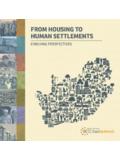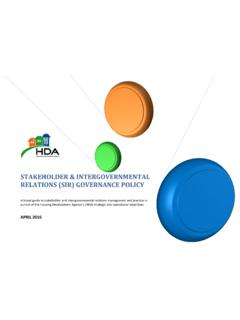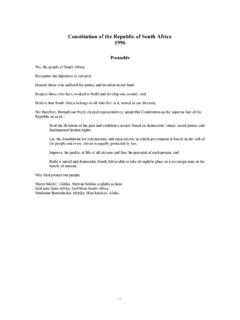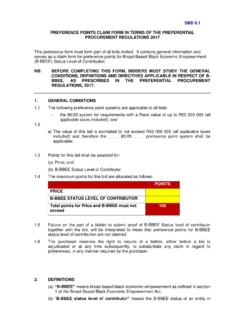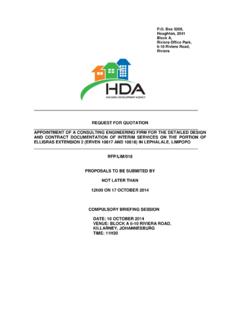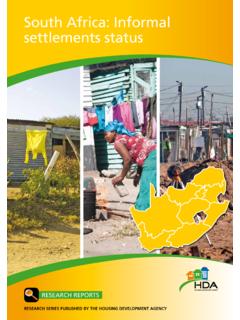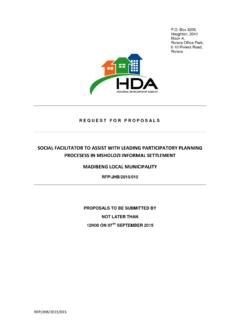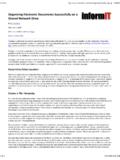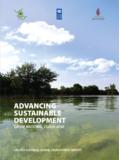Transcription of CONCEPT NOTE Human Settlements Spatial …
1 CONCEPT NOTE Human Settlements Spatial planning framework (SPF) FINAL DRAFT OCTOBER 2014 2014/10/16 1 CONTENTS 1. Introduction .. 2 2. Understanding the Mandate .. 3 3. The Spatial planning framework (SPF): Translating the mandates into Spatial interventions .. 4 4. Purpose of the SPF .. 5 5. Spatial principles .. 5 6. Spatial targeting principles .. 6 7. Prioritisation within the Human settlement sector to meet demand .. 7 8. Classification of projects according to criteria.
2 9 9. Suggested benchmarking for investment .. 11 10. Programmes and planning .. 12 11. Conclusion .. 13 Annexure 1: List of prioritised municipalities with catalytic projects .. 15 Acknowledgements: Department of Human Settlements : planning Unit Housing Development Agency Adaptations of Monty Narsoo s financial motivation for Human Settlements Master Spatial Plan 2014/10/16 2 1. Introduction The realities of poverty, inequality and unemployment are still the major challenges facing South Africa twenty years into democracy.
3 A decade ago in the 10 Year Review, poverty is understood to involve three critical dimensions: income, Human capital (services and opportunity) and assets. The Comprehensive Plan for Integrated Human Settlements (dubbed Breaking New Ground) in 2004 made the case that these problems were manifested in Spatial terms: `..the inequalities and the inefficiencies of the apartheid space economy, have lingered on. The lack of integration between housing plans and land use, transportation and bulk municipal infrastructure investment planning has meant that the existing Spatial fabric has shown little change with housing for low-income urban dwellers still being provided on the periphery and very limited housing delivery taking place in the rural context.
4 This problem found echoes in the National Spatial Development framework (NSDP), which in 2004 was an indicative framework to inform decisions on infrastructure investment and development spending, because it was concerned that national investment and development programmes were not fully addressing the distortions of the inherited apartheid space economy. In particular, the NSDP noted that new housing delivery has in fact exacerbated Spatial distortions. The situation has altered little in the last ten years despite the impressive house-building programme that has improved the lives of nearly three million households through tenure, basic services and housing.
5 There had been a concerted policy attempt to address these issues by the Comprehensive Plan. The key message of the plan was that Human settlement development should be demand driven and supply negotiated, and by social contract with key stakeholders. This yielded some improvements but not on a scale that changed the landscape where poverty, inequality, and unemployment is still visible in Spatial terms in Human Settlements . This has been exacerbated by the rapid urbanisation that has occurred in the last two decades where people seeking livelihoods and employment are largely located in informal Settlements .
6 By 2030 over seventy per cent of South Africa s population will live in urban areas. In the framework of integrating neighbourhoods and Settlements - making them more efficient to provide access to economic opportunities and providing services and amenities - shelter becomes a major imperative in government s attempt to address the distorted Spatial economy. The key issue is the economy and how it manifests itself in Spatial terms: - Inadequacy of dwellings in terms of resilience to disasters and compliance - Limited access to dignified level of diverse services - Distances between work and home effect the poorest people s disposable income most adversely - The pressure on the mobility networks (vehicular)
7 And limited supply and safety of non-motorised mobility routes and public transport - Limited choice in location of affordable housing opportunities - The programmatic focus on large-scale spectrum of the economy - The culture of non-payment that negatively influences the delivery of mixed-income Settlements - The dominance of greenfields development A strategic and systematic response, based on real understanding of the demand and supply dynamics in Human Settlements and how they play out in Spatial terms, is needed if integrated neighbourhoods and Settlements are to be developed.
8 This increased understanding should also provide the basis for a more efficient and effective direction of investment. 2014/10/16 3 Figure 1: Categorising delivery according to Master Spatial Plan In order to meet the UN- Habitat Sustainable Development Goals articulated as compact, connected and integrated Settlements , the Spatial , financial and legislative components complement each other. The transformation of the Spatial environment from the current to the envisaged future condition of an integrated settlement requires the application of an interim mechanism.
9 Implementing such a mechanism, allows and supports the bridging from the previous condition of the environment to the new envisaged integrated condition of the environment, considering the lengthy time frames for legislative change. The application of the recently gazetted Priority Housing Development Area (PHDA) regulation (September 2014) is such a transformative mechanism. It implies that the Minister can approve state lead developments that demonstrate the meeting of new objectives to enable Spatial transformation.
10 2. Understanding the Mandate Chapter 8 of the National Development Plan (NDP) Transforming Human Settlements and the national space economy , and its vision for urban South Africa states: By 2030 South Africa should observe meaningful and measurable progress in reviving rural areas and in creating more functionally integrated, balanced and vibrant urban Settlements . For this to happen the country must: clarify and relentlessly pursue a national vision for Spatial development; sharpen the instruments for achieving this vision; [and] build the required capabilities in the state and among citizens.

